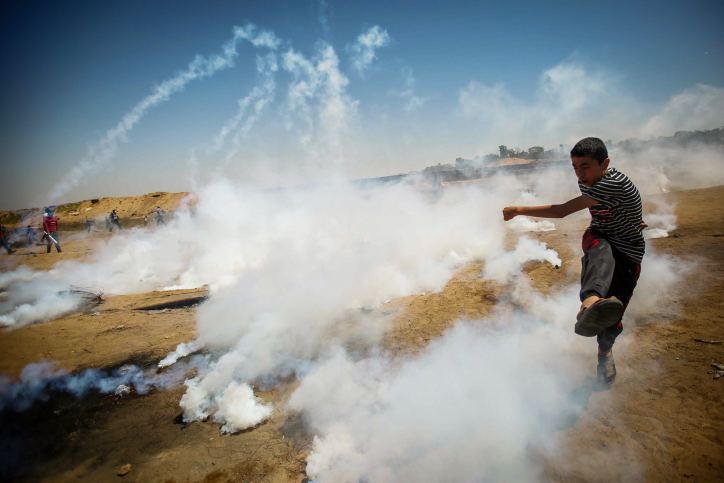A year ago, Israeli forces gunned down 64 demonstrators during Gaza’s Great Return March. Palestinian journalist Hind Khoudary was there to see it all — the bloody stretchers, the wounded, and the dead.
By Hind Khoudary

GAZA CITY — F16s are flying on low velocity over the Gaza sky as I get flashbacks to May 14 of last year. I don’t know if I will ever be able forget all the scenes I witnessed on that ugly day. The images I witnessed are carved into my brain and heart until today, perhaps forever.
It was very early in the morning, everyone was predicting a backlash from the Palestinians after the U.S. opened its embassy in Jerusalem. I headed to the protest area early that day; women, men, and children waved Palestinian flags and chanted slogans against Trump.
I was working with two news outlets and as a fixer with internationals. Even today I have no idea how I was able to cope with all of the workload. By 11 a.m. the internet was disconnected entirely. No signal.
Suddenly, all I heard were ambulances. The wounded on crutches, live ammunition and tear gas canisters fired into the air. The next thing I knew, paramedics were washing blood from the stretchers, their uniforms turning red.
The situation grew more dangerous. My phone wouldn’t stop ringing — everyone was trying to call me to make sure I was okay. I said I was, but my trembling voice and the screaming in the background told a different story.
Running out of breath with the heavy flack jacket, we hid from live ammunition under the burning sun while suffocating from tear gas for hours. The scene was so bad that I couldn’t speak for two days.
I won’t ever forget the scene of the 30-year-old man shot in the middle of his head in front of my eyes, the little children crying from teargas as they searched for their parents, the Israeli soldiers stationed behind the fence arresting three boys and beating them up, the 80-year-old woman who participated in the march, demanding the right to return because she still believes she will go back to the town she was expelled from someday.
Bashir Faraj, 23, lost his right leg after he was hit by live bullets that completely fractured his bones and tissues. His leg was eventually amputated. I met Faraj a day after his injury, when he was screaming in the hospital bed with the external fixture on his right leg. He never thought he will lose his leg. Faraj was only one of the hundreds of Palestinians my age that I interviewed who lost limbs — and their futures — that day. All in all, 64 people lost their lives that day, and thousands more, like Faraj, were wounded.

I have no idea if May 15 will be a new deadly day this year, if the Israeli forces will use lethal force against Palestinian protesters. But whether they do or not, Palestinians in the Gaza Strip have the right to protest the harsh conditions they have been facing over the past 12 years under the blockade. Unemployment, poverty, and depression are part of every home here. Despite the fact that the Great Return March has been politically weaponized over the past months, the people of Gaza are still protesting because they still have hope that they can remove the blockade and improve the lives of the two million Palestinians living here.
Despite all the difficulties I witnessed as I covered the protest — the violence, the blood, and the injustice — I will continue to report and raise the voice of the voiceless people in the Gaza Strip, today, tomorrow, and forever.
Hind Khoudary is a reporter based in Gaza.
